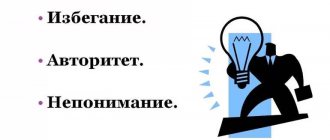Imagine a state in which a person feels weakened physically, morally and mentally.
The individual does not understand what is happening to him, the working day seems endless and dull, it is impossible to concentrate on performing any function, to perform a certain operation on time and well. Professional activity does not bring the same satisfaction. Even the smallest failure unsettles you, makes you give up, and haunts you with irritability and resentment. And this is not the blues, but the so-called burnout syndrome. If previously it was associated with exhaustion and a person’s feeling of uselessness, now the situation has changed. Now a psychosomatic component has been added to these factors, and experts are inclined to consider this condition a pre-disease.
This phenomenon of personality deformation is included in the ICD under number Z73 under the heading “Stress associated with difficulties in maintaining a normal lifestyle.” It is quite common in the world.
It is very important to notice the first manifestations of this mental disorder in time and immediately take measures to eliminate it, since if it is allowed to develop, it will lead to a serious nervous breakdown.
general characteristics
There are several definitions of this term, but they all boil down to one essence. The name of the state of exhaustion was given by psychologist H. Freudenberger.
Emotional burnout (burnout) is a state of a person in which his psychological defense is triggered in response to specific psychotraumatic influences. In this case, psychological defense is the complete or partial exclusion of emotions.
In simple words, in such a state a person has no strength to laugh or cry; he lacks vital energy to react to the situations that happen to him. At this moment, the mechanism of emergency dosed and economical energy consumption “turns on” in the psyche. This manifests itself in a person’s personal life, professional sphere, and communication with people.
Human burnout occurs when we do the same things day after day, but do not see their results or do not feel progress. Because of this, our health, performance, and relationships with others deteriorate. The person becomes nervous, irritable, and “withdraws into himself.”
Relationship with stress
Infantility in men - what does it mean, signs and causes
To understand how burnout and stress are related, you need to study the mechanism of its occurrence. Nervous exhaustion often occurs in professional environments. Usually occurs when:
- A person is constantly in stressful situations that replace each other;
- Does not derive pleasure from completing tasks or rewards.
The financial side does not come first. A person must realize that his work is valued. If this does not happen, then after another stress of moderate intensity, experiences and changes in the psycho-emotional sphere begin, leading to burnout.
The tension has especially worsened recently, when people began to realize that they do not have a stable position, could lose their jobs at any time and be left without a livelihood. Competition between applicants is growing, which can only mean one thing – tougher requirements for them. The salary level remains the same. All this keeps the population in constant stress and does not allow them to relax.
Stressed man at work
Symptoms of SEV
Emotional burnout syndrome (EBS) is not a disease, but a set of symptoms that make up a picture of a person’s condition. It does not just arise; there are certain precursors that lead to this syndrome. Like me, not everyone immediately understands what is happening to them. Therefore, they do not react immediately, which worsens their condition.
Symptoms of SEV are:
- constant fatigue, weakness, lethargy;
- frequent headaches;
- decreased immunity, lack of normal sleep;
- decreased vision, pain in the back;
- eating disorder – stress “gets stuck” or “a piece won’t go down your throat”;
- the desire to escape from everyone, to be alone with oneself;
- avoidance of responsibility, laziness, accumulation of unfinished work;
- resentment, accusations, irritability;
- envy and complaints about life, the luck of others;
- a person feels sorry for himself for working hard, for having to “waste” his life;
- negativity and pessimism towards everything;
- indifference to oneself and others;
- state of disappointment;
- self-esteem decreases;
- no interest in professional development or your work;
- short temper, constant bad mood, depression (here is described how to help yourself in this case).
As you can see, emotional burnout affects the psycho-emotional, physical sphere of a person, as well as his behavior in society. Therefore, it is very important to solve the problem with your condition in a timely manner.
In addition to your behavior and internal feelings, you will probably notice that you have become less productive at work. You take on the volume that you completed in one working day, but now you can’t handle it in three. If you do not solve the problem with the emotional sphere, over time your performance will decrease, and, in addition to internal problems, external ones will also be added: where to get money, for example.
Training
Friends, if you want to start actively working right now to reduce the level of stress in your life, clear your mind and reboot your consciousness, I advise you to take the “Brain Detoxification” course, which will help you:
- Focus on what's important.
- Reduce stress and anxiety levels.
- Improve the quality of sleep and rest.
- Reduce distraction.
- Get rid of toxic thoughts.
The training consists of 10 lessons and practical tasks. You will receive tools and exercises, as well as video and audio materials. At the end of the course, they will give valuable recommendations for independent practice.
The author of the online training is Victor Shiryaev, an expert in the field of integral philosophy and developmental psychology.
Stages
CMEA is divided into stages. Doctors and psychologists need such a division in order to know “which swamp” to pull a person out of, and how much he is mired in it. One of the first researchers who undertook to determine this problem was V.V. Boyko. The psychologist has developed special techniques that determine a person’s state and 4 stages (phases) of his emotional burnout. Let's look at them.
- Voltage. This is the initial stage of burnout, its harbinger. A person is very worried about a traumatic situation (a child gets sick, the end of a relationship, problems at work). Despair accumulates, a state of dissatisfaction with oneself and one’s behavior. There is a feeling of helplessness, “caged in a cage.” The man is anxious and disappointed in himself.
- Resistance. In other words, the personality begins to resist and defend against this state. Callousness and indifference are growing, and the problems of subordinates and other people with whom you need to interact are not taken into account. Therefore, we sometimes complain about doctors when they are indifferent to patients, about teachers when they “treat all children with the same brush,” and they have the 2nd phase of SEV.
- Exhaustion. The person himself does not fully understand that this is happening to him. The overall tone of the body decreases, the nervous system is weakened. Getting used to “the way you are” occurs, so callousness, irritability and resentment become characteristics of the individual. This is dangerous because she can demonstrate her indifference to everyone around her.
- Depersonalization. Personality undergoes major changes. It is no longer just at work or in one particular area that a person is burned out. This is already manifested in all areas; character traits and values change. A person can declare “how I hate everyone,” “I would strangle you,” etc. This already borders on psychopathology. Somatic manifestations of SEV appear.
Who usually gets it and for what reasons?
Why doesn’t a person burn out under every stress? So, SEV is not associated with stress? No, there is a relationship, but it is a cumulative state, like a constant lack of sleep. So let’s look at the factors in the development of emotional burnout and who is susceptible to it:
- people striving for ideals;
- individuals who are characterized by feelings of guilt with or without cause;
- touchy people and people with high expectations and demands;
- naive and individuals “with rose-colored glasses”;
- wanting to please everyone.
For example, my problem is that I always want an ideal relationship, ideal children, ideal purity. And do you think I can achieve this? No! Firstly, the concept of ideal even among my loved ones is different, and secondly, this is not real! And I, it must be said, had the “honor” of getting out of the CMEA, which was not easy.
We continue the list of groups of people who have every chance of becoming burnt out:
- medical workers - signs of SEV begin in them after several years of work (for some even earlier);
- teachers in schools, universities;
- people in the service industry who work with people who are not very polite;
- managers, executives, businessmen, entrepreneurs;
- workers in creative professions (artists, designers, actors).
All those who do not see the benefits of their work are susceptible to professional burnout. And CMEA is observed for the following reasons:
- there is no connection between the expended personal resources (energy, time, emotions) and the result obtained;
- ambitious goals, but little time;
- a person does not know how to regulate his emotions;
- increased sense of responsibility and greater physical activity;
- a person is not taught how to get out of difficult situations, does not know how to communicate correctly.
Diagnostics
You will easily find out when you have stage 3 or 4 of emotional burnout, since your whole body will be screaming about it. But in the early stages, it is important to undergo timely diagnosis, or self-diagnosis, in order to adjust your daily routine, reactions to stress, and, in general, take care of yourself.
I present to you several methods that will help you diagnose the level of SEV.
- “Diagnostics of the level of emotional burnout” - test by V. Boyko. You can take the test online using this link. You have to answer 84 questions. Answer immediately without thinking, this increases the likelihood of a truthful result. This is a well-known questionnaire that has been tested for reliability by large-scale research.
- “Maslach Burnout Questionnaire.” This technique was tested on health workers, but is applicable to all professions. Its main focus is measuring indicators of professional burnout. This is a separate topic in psychology, which is studied using this particular questionnaire.
- “Definition of mental burnout” A. Rukavishnikov. You have to answer 19 questions. The test shows “what level” your personality is at. It has a gradation of 3 scales that show psycho-emotional exhaustion, personal distance, and professional motivation.
- Vodopyanov’s test “Burnout Syndrome”. This test is good because it is adapted for different professions. The psycho-emotional state of a person is studied on the following scales: emotional exhaustion, depersonalization, professional success.
These tests help identify problems in different professions: trade workers, managers, executives, teachers. But, for example, I like Boyko’s method; the test is suitable for all people. Even mothers on maternity leave can take it if they feel like it’s getting worse. And, in principle, everyone who suffered burnout outside the profession.
Statistics show that women are more likely to burn out because they have to communicate more at home and at work. Although, for example, the WHO in May 2021 defined CMEA as a syndrome that occurs in the workplace due to chronic stress. And the document says that such a condition is recognized as a disease only in the case of professional burnout.
To know when SEW is considered a disease and when it is just a syndrome, it is important to understand what is included in the concept of “professional burnout.”
The person is exhausted, lacks energy, and is psychologically detached from his professional activities. There is cynicism and negativism. He exhibits professional deformation - when a certain behavior at work is fixed as a personality characteristic. This is clearly visible in teachers: the desire to teach everyone, to consider themselves the main thing in any company, etc.
Second reason: unfavorable economic situation in the country
The economic crisis that our country is experiencing has an adverse effect on the working atmosphere of Russian enterprises. Many companies have begun to reduce their costs and reduce their staff, and distribute the functions of laid-off workers among the remaining specialists as an additional burden. Such a management decision causes internal dissatisfaction, disagreement, or even protest among employees. As a result, a person does not like the current situation and begins to think about whether he works there, whether he is doing his own thing, and whether it is time for him to change something in his life.
How to deal with burnout
It is necessary to fight the syndrome and the sooner the better. Various activities and taking care of your physical health help you cope with SEV. Ways to overcome emotional burnout are known to many, we even know how best to use them, but are we doing it? Let's start with the fact that not all employers know that they are also responsible for the recovery of employees after heavy workload.
We already know that SEV manifests itself in three aspects. When a person is wondering what to do about their condition, it is important to focus on managing symptoms in all three areas.
Psychologist's advice
- Massage. Considering that SEV affects the human body and is manifested primarily by muscle spasms, it is important to start relieving it. There are many techniques for removing the “armor of tension,” but they are ineffective. Therefore, I recommend starting with a relaxing massage. Find a knowledgeable massage therapist and trust him with your “shell”!
- Learn to relax. To do this, sometimes you need the willpower to break away from work, stress and decision-making. Both the body and consciousness should rest. Try to turn off all gadgets, TV, and computer 2–3 hours before bedtime. Keep track of the balance of physical and psychological stress; if you are not physically tired, then when you go to bed, you will not be able to fall asleep, being mentally tired.
- Get active. If you lead a sedentary lifestyle, you should (no, you simply must!) start moving. These are jogging, exercises, the gym, etc. Movement and water are the best recovery after an intellectually difficult day for our body, especially for the brain, digestion and immunity.
- Get enough sleep. I know from myself that chronic lack of sleep slows down brain function, the speed of physical reactions and reduces ability to work. A person needs to sleep at least 6 hours a day, but for many this is not enough: 7–8 hours is the norm for an adult, and even more for a child, depending on age. Get quality sleep, without flashing lights, high pillows, etc.
- Learn to communicate. Often we ourselves fall into the trap of burnout due to the fact that we do not know how to communicate, are not prepared for stress, and do not know how to negotiate. This leads to emotional exhaustion. Therefore, learn to build relationships, communicate, negotiate, and defend your interests. Learning proper verbal communication will help you cope with stress.
- Try to be flexible. Flexibility is a skill that helps you respond adequately to changes in life. Our lives are constantly changing, and it is quite difficult for conservative people to accept these changes. Therefore, there is an exhaustion of emotions in the struggle for the old life.
- If you're stuck at work and you can't stand it anymore, it's time to take a vacation. But if that doesn't help, no one is forcing you to work a job you hate. By the way, you need to be able to quit without harming your nerves. In this article about competent dismissal you will find many useful tips.
- Active rest or change of scenery. This is what helps to reboot the emotional sphere, to be filled with new impressions and exciting events. This is a great distraction and reveals the internal mechanisms of mental recovery.
- Don't forget about yourself during the working day. Try to take breaks, go outside sometimes, reboot your brain, especially when you receive a lot of information.
- Learn to say no. This will be great for asserting personal boundaries, which will also protect you from burnout. But this must be done tactfully so as not to conflict. Conflicts, by the way, also take away energy. And you will learn how to resolve conflicts in this article.
- Create a ritual for shedding your work clothes. Psychologically, by taking off the work clothes of an office worker or teacher, you take off the entire workload of the working day, problems and unresolved tasks.
Exercises
Many psychologists agree that the best exercises to overcome this syndrome are elements of yoga, auto-training and training, where all problems are worked out, the attitude towards them changes, and internal resources are searched and restored. Let me present a few exercises:
- Breathing exercises - listen to your breathing, start breathing deeply, hold your breath, then exhale on a count of 5, do this up to 20 times;
- Relaxation - lie on the floor with your arms and legs spread out, lie there for 1 - 2 minutes, with your eyes closed, imagine the room you are in, listen to your breathing, breathe slowly, alternately strain your limbs, shake your head;
- Gradual relaxation of all parts of the body, as well as self-massage techniques, begin to massage the limbs from the bottom up - this will help the lymph remove toxins from the body, which is also useful in the process of cleansing the body and psyche.
Books and videos
The scientific novelty of the problem prompted many scientists to study the topic of CMEA. This makes it possible to study new ways to combat this condition, since getting out of it is important not only for adults, but also for schoolchildren, students, family members involved in various projects and clubs. Below is a list of literature, books that will help you study SEV and find recommendations for overcoming it.
- Devorah Zack “Uniqueness”.
- Ched-Meng Tan “Joy from Within.”
- Tal Ben Shahar “The Perfectionist Paradox.”
- L. Petranovskaya “Lecture “I can’t do it anymore.”
- A.V. Mishchenko “Personal determinants of emotional burnout of sports coaches.”
- Y. Ayupova “No burnout.”
- J. Greenberg “Stress Management.”
In addition to books, you can watch great videos that will help you understand your condition and learn how to overcome it and avoid it in the future. For example, Evgenia Streletskaya explains this state well in her lecture “Emotional burnout. Treatment by stages. Sabbatical.”
Training
To pump up your brain, cleanse yourself of negativity and prevent the appearance of SEV, I advise you to attend trainings. But if it is not possible to attend them in person, there is an excellent course “Brain Detoxification”. It helps to pump up the brain, learn to concentrate on what is important, relax, increase performance, manage emotions without harming oneself.
As you go through it, you will learn to cope with stress, anxiety and worry. The course leader is Viktor Shiryaev, a specialist in developmental psychology. But if practical and theoretical tasks do not help, then you need psychotherapy to free yourself from accumulated unnecessary information. By the way, psychotherapy methods also help solve the psychosomatic aspects of the problem.
Treatment
The patient’s motivation and the support of loved ones play a big role in eliminating the symptoms of SES. At the first stage, a person is quite capable of coping with the syndrome on his own. To do this, sometimes it is enough to change your work schedule, reconsider your value system, have a good rest and take your mind off problems.
In more advanced cases, the help of a psychotherapist is necessary. Treatment is carried out comprehensively using the following methods:
- psychotherapy;
- medicines;
- change in work environment.
During psychotherapy sessions, the doctor changes the patient’s personal attitudes in relation to professional activities. It re-shapes the patient’s motivation and interest in work. It also teaches him how to properly distribute time and energy into various areas of life.
Psychotherapists use the following techniques and exercises.
- Communication skills training . It teaches the patient the ability to communicate effectively with other people. Its main task is to help the patient realize the importance of the presence of loved ones in his life.
- Teaching optimism . This training teaches the patient to perceive events not from a negative side, but from a more positive one.
- Prevention of frustration . This technique helps the patient to realistically assess his abilities and capabilities.
- Magic shop . In this exercise, the patient imagines that he is in a magic shop. In this store he can acquire any character trait that he thinks he lacks. The purpose of the exercise is to increase the patient’s self-esteem.
- Psychological debriefing . It represents a conversation between a doctor and a patient who has encountered a difficult event. The patient expresses his thoughts, describes sensations and feelings about the experience.
Depending on the clinical picture and severity of the syndrome, the doctor prescribes medications. It can be:
- antidepressants;
- beta blockers;
- sleeping pills;
- tranquilizers.
Drug treatment is carried out exclusively according to the doctor’s indications and under his supervision.
Unfortunately, there is no magic bullet that will help you avoid or instantly cure burnout. This is always a lot of work on yourself, on the ability to live harmoniously. If you devote all your time and energy to just one aspect of your life, burnout will inevitably occur. This is perhaps the main reason for the CMEA.
Prevention
To prevent SEV, it is important to stop worrying about everything and learn to cope with stress. Otherwise, the consequences of the burnout phenomenon can turn into a big problem. What needs to be done to prevent SEV:
- If you realize that you are experiencing emotional burnout, try not to give up. Form your “positive self-image”. Remind yourself that you will succeed, that everything will pass, and you will be fit again. Support yourself.
- Maintain a work-rest balance. This is especially important for teenagers who are going through a transition period in their mind and body. Parents do not always understand this and burden them with new responsibilities and studies. And sometimes a teenager needs to drop everything and get a good night's sleep.
- Get regular exercise. For men, this happens more often, since they are not burdened with children and family responsibilities. But no matter how old you are, physical activity never hurts. In sports, a person develops physically, which gives him energy and physical strength.
- Don't exhaust yourself, get enough sleep. Moreover, you need to get enough sleep in proportion to the load. If the previous day was hard, sleep longer.
- Delegate the load. Don't take it all on yourself. Try to distribute your responsibilities if you cannot cope with them. Prevention methods and techniques are based on this, when a person knows how to stop in time and not take on more than he can take on.
- Find yourself a hobby. Life does not end with a relationship with a man/woman or a job. It is important to continue to develop, which gives energy and emotions.











